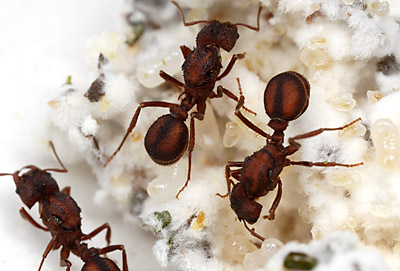
Multiple foundress queens of Acromyrmex versicolor atop their shared fungus garden.
A striking result from recent studies on the co-evolution of leafcutter ants and their fungus is that the two lineages do not show a tight pattern of coevolution. That is, the evolutionary relationships among the fungal lines often deviate from the phylogenetic trees shown by the ants. When ant populations speciate, the fungus doesn't follow.
The lack of cospeciation was puzzling, as the ants and the fungus are intertwined a tight ecological relationship. Each requires the other to survive. The fungus is fed and dispersed by ants, while the ants obtain their energy and nutrients by eating the fungus. The situation should encourage a close specialization that increases the efficiency of the interaction and prevents partner-switching, linking the lineages into a common evolutionary pattern. Plus, it wasn't at all clear when the fungus had the opportunity to swap host lineages, as the fungus spends most of its time in the underground gardens and is moved to new nests safely inside the mouthparts of dispersing queens.
A new paper by Poulson et al in the journal Evolution answers the riddle:Â fungus-growing queens often start nests in groups, allowing their fungi to mingle early on in the association and providing an opportunity to swap among ant lineages. Â Here's the abstract:
Abstract: Evolutionary theory predicts that hosts are selected to prevent mixing of genetically different symbionts when competition among lineages reduces the productivity of a mutualism. The symbionts themselves may also defend their interests: recent studies of Acromyrmex leaf-cutting ants showed that somatic incompatibility enforces single-clone gardens within mature colonies, thereby constraining horizontal transmission of fungal symbionts. However, phylogenetic analyses indicate that symbiont switches occur frequently enough to remove most signs of host-symbiont cocladogenesis. Here we resolve this paradox by showing that transmission among newly founded Acromyrmex colonies is not constrained. All tested queens of sympatric A. octospinosus and A. echinatior offered a novel fragment of fungus garden accepted the new symbiont. The outcome was unaffected by genetic distance between the novel and the original symbiont, and by the ant species the novel symbiont came from. The colony founding stage may thus provide an efficient but transient window for horizontal transmission, in which the fungus is unable to actively defend its partnership position before the host feeds on it, so that host fecal droplets remain compatible with alternative strains during the early stage of colony founding. We discuss how brief stages of low commitment between partners may increase the evolutionary stability of ancient coevolved mutualisms.
